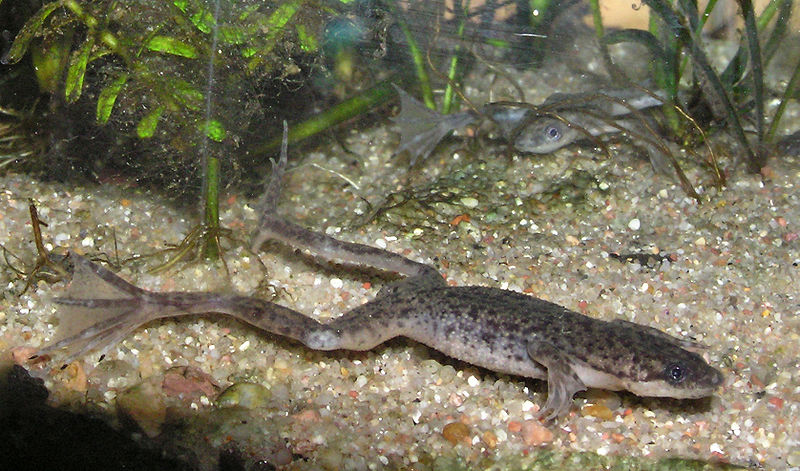For as long as I can recall, distinguishing between young African clawed frogs (Xenopus laevis) and adult dwarf clawed frogs (Hymenochirus boettgeri or H. curtipes) has been problematical for many frog keepers (and pet store employees!). The question is more than academic, because both are exceedingly common and popular in the pet trade, and their care differs radically.
Distinguishing the Species
 Both are members of the frog family Pipidae, a group of 32 species of aquatic, tongue-less and thoroughly engaging creatures. Included the Pipidae is the bizarre, back-brooding Surinam toad (Pipa pipa) and its 5 relatives.
Both are members of the frog family Pipidae, a group of 32 species of aquatic, tongue-less and thoroughly engaging creatures. Included the Pipidae is the bizarre, back-brooding Surinam toad (Pipa pipa) and its 5 relatives.
The two can be easily distinguished by closely examining the front feet. If the fingers are webbed, then the frog is a dwarf clawed frog. If they are not webbed, then it is a baby African clawed frog. Both have webbed feet.
There are subtle differences as well – dwarf frogs are even more flattened in shape than their larger cousins, and have somewhat pointed (as opposed the African clawed frog’s rounded) heads.
Lifestyle and Care Differences
African clawed frogs are boisterous, hardy beasts that eat most anything, prepared foods included, and are easily trained to feed from the hand. Captive longevity approaches 30 years.
Dwarf clawed frogs are live food specialists. Tiny and slow moving, they incessantly search the substrate for worms and other invertebrates, and do best in warm, densely-planted aquariums. A breeding group makes for an enchanting display.
Frogs and Fish?
 Unfortunately, both are often sold as “oddities” for tropical fish aquariums. This situation rarely works out…African clawed frogs consume all but the largest of fishes, and dwarf frogs are inevitably out-competed for food and perish in short order.
Unfortunately, both are often sold as “oddities” for tropical fish aquariums. This situation rarely works out…African clawed frogs consume all but the largest of fishes, and dwarf frogs are inevitably out-competed for food and perish in short order.
There are major differences in the care of both species, which I’ll cover in detail in the future. Until then, please write in with your questions and comments. Thanks, Frank Indiviglio.
Further Reading
I’ve long been fascinated by aquatic frogs, and have bred a number of species. Please see my article African Clawed Frog Behavior for some unusual observations upon which I’m seeking the comments of other frog enthusiasts.
Both frogs can be bred in captivity, and their tadpoles have a most unusual feeding strategy. For more information and a video clip, please see Suction Feeding in H. boettgeri.
Dwarf Clawed Frog Image referenced from Wikipedia and originally posted by Mwatro
 That Reptile Blog – Reptile, Amphibian and Exotic Pet Care and Information
That Reptile Blog – Reptile, Amphibian and Exotic Pet Care and Information

